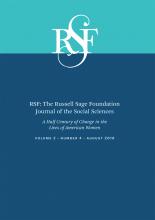Research Article
Open Access
Motherhood and the Wages of Women in Professional Occupations
Claudia Buchmann, Anne McDaniel
RSF: The Russell Sage Foundation Journal of the Social Sciences August 2016, 2 (4) 128-150; DOI: https://doi.org/10.7758/RSF.2016.2.4.05
Claudia Buchmann
aProfessor of sociology at the Ohio State University
Anne McDaniel
bAssociate director in the Center for the Study of Student Life at the Ohio State University

REFERENCES
- ↵
- ↵
- Anderson, Deborah J.,
- Melissa Binder, , and
- Kate Krause
- ↵
- Avellar, Sarah, and
- Pamela J. Smock
- ↵Bianchi, Suzanne M., John P. Robinson, and Melissa A. Milkie. 2006. Changing Rhythms of American Family Life. New York: Russell Sage Foundation.
- ↵Blair-Loy, Mary. 2003. Competing Devotions: Career and Family Among Women Executives. Cambridge, Mass.: Harvard University Press.
- ↵
- Bolzendahl, Catherine, and
- Daniel Myers
- ↵Boushey, Heather. 2005. “Are Women Opting Out? Debunking the Myth.” Briefing Paper. Washington, D.C.: Center for Economic and Policy Research.
- ↵
- Budig, Michelle J., and
- Paula England
- ↵
- Budig, Michelle J., and
- Melissa J. Hodges
- ↵
- ↵Chao, Elaine L., and Philip L. Rones. 2007. “Women in the Labor Force: A Databook.” Washington, D.C.: Bureau of Labor Statistics. Accessed April 11, 2016. http://www.bls.gov/opub/reports/womens-databook/archive/women-in-the-labor-force-a-databook-2014.pdf.
- ↵Coltrane, Scott. 1997. Family Man: Fatherhood, Housework, and Gender Equity. New York: Oxford University Press.
- ↵Coser, Lewis. 1974. Greedy Institutions: Patterns of Undivided Commitment. New York: Free Press.
- ↵Cotter, David A., Joan M. Hermsen, and Reeve Vanneman. 2004. Gender Inequality at Work. New York: Russell Sage Foundation.
- ↵DiPrete, Thomas A., and Claudia Buchmann. 2013. The Rise of Women: The Female Advantage in Education and What It Means for American Schools. New York: Russell Sage Foundation.
- ↵
- England, Paula
- ↵Galinsky, Ellen, Kerstein Aumann, and James T. Bond. 2009. Times Are Changing: Gender and Generation at Work and Home. New York: Families and Work Institute.
- ↵
- Glass, Jennifer
- ↵
- Glauber, Rebecca
- ↵
- ↵
- Glauber, Rebecca
- ↵
- ↵
- Goldin, Claudia, and
- Lawrence F. Katz
- ↵Goldin, Claudia, and Lawrence F. Katz. 2012. “The Most Egalitarian of All Professions: Pharmacy and the Evolution of a Family Friendly Occupation.” NBER working paper no. 18410. Cambridge, Mass.: National Bureau of Economic Research.
- ↵Gornick, Janet C., and Marcia K. Meyers. 2003. Families That Work: Policies for Reconciling Parenthood and Employment. New York: Russell Sage Foundation.
- ↵
- ↵
- Greenman, Emily
- ↵
- Harkness, Susan, and
- Jane Waldfogel
- ↵
- Hertz, Rosanna
- ↵
- ↵
- Hook, Jennifer
- ↵Jacobs, Jerry A., and Kathleen Gerson. 2004. The Time Divide: Work, Family, and Gender Inequality. Cambridge, Mass.: Harvard University Press.
- ↵
- Killewald, Alexandra
- ↵
- Killewald, Alexandra, and
- Jonathan Bearak
- ↵
- Lundberg, Shelly, and
- Elaina Rose
- ↵Marini, Margaret M., and Mary C. Brinton. 1984. “Sex Typing in Occupational Socialization.” In Sex Segregation in the Workplace: Trends, Explanations, Remedies, edited by Barbara F. Reskin. Washington, D.C.: National Academies Press.
- ↵
- Percheski, Christine
- ↵
- Percheski, Christine, and
- Christopher Wildeman
- ↵
- Petersen, Trond,
- Andrew M. Penner, , and
- Geir Hogsnes
- ↵
- Ridgeway, Cecilia L., and
- Shelly J. Correll
- ↵Ruggles, Steven, J. Trent Alexander, Katie Genadek, Ronald Goeken, Matthew B. Schroeder, and Matthew Sobek. 2010. Integrated Public Use Microdata Series: Version 5.0 [Machine-readable database]. Minneapolis: University of Minnesota.
- ↵
- Sayer, Liana
- ↵
- Staff, Jeremy, and
- Jeylan T. Mortimer
- ↵
- Taniguchi, Hiromi
- ↵
- Waldfogel, Jane
- ↵Wang, Wendy, Kim Parker, and Paul Taylor. 2013. Breadwinner Moms. Washington, D.C.: Pew Research Center.
- ↵
- Yavorsky, Jill E.,
- Claire M. Kamp Dush, , and
- Sarah J. Schoppe-Sullivan
In this issue
Motherhood and the Wages of Women in Professional Occupations
Claudia Buchmann, Anne McDaniel
RSF: The Russell Sage Foundation Journal of the Social Sciences Aug 2016, 2 (4) 128-150; DOI: 10.7758/RSF.2016.2.4.05
Jump to section
- Article
- Abstract
- PRIOR RESEARCH
- GROWING HETEROGENEITY IN THE FAMILY WAGE GAP FOR WOMEN
- DATA AND METHODS
- CHANGE IN WOMEN'S PARTICIPATION IN PROFESSIONAL OCCUPATIONS
- CHARACTERISTICS OF ELITE, PROFESSIONAL WOMEN
- THE FAMILY WAGE GAP
- PARENTHOOD AND THE WAGES OF PROFESSIONAL WOMEN AND MEN
- RACIAL DIFFERENCES IN THE FAMILY WAGE GAP
- CONCLUSION
- Acknowledgments
- APPENDIX
- FOOTNOTES
- REFERENCES
- Figures & Data
- Info & Metrics
- References
Related Articles
- No related articles found.
Cited By...
- No citing articles found.





